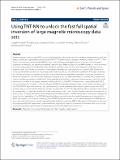Using TNT-NN to unlock the fast full spatial inversion of large magnetic microscopy data sets
Author(s)
Myre, Joseph M; Lascu, Ioan; Lima, Eduardo A; Feinberg, Joshua M; Saar, Martin O; Myre, Joseph M.; Feinberg, Joshua M.; Saar, Martin O.; Lima, Eduardo A.; Weiss, Benjamin P.; ... Show more Show less
Download40623_2019_Article_988.pdf (3.119Mb)
PUBLISHER_CC
Publisher with Creative Commons License
Creative Commons Attribution
Terms of use
Metadata
Show full item recordAbstract
Modern magnetic microscopy (MM) provides high-resolution, ultra-high-sensitivity moment magnetometry, with the ability to measure at spatial resolutions better than 10⁻⁴ m and to detect magnetic moments weaker than 10⁻¹⁵ Am². These characteristics make modern MM devices capable of particularly high-resolution analysis of the magnetic properties of materials, but generate extremely large data sets. Many studies utilizing MM attempt to solve an inverse problem to determine the magnitude of the magnetic moments that produce the measured component of the magnetic field. Fast Fourier techniques in the frequency domain and non-negative least-squares (NNLS) methods in the spatial domain are the two most frequently used methods to solve this inverse problem. Although extremely fast, Fourier techniques can produce solutions that violate the non-negativity of moments constraint. Inversions in the spatial domain do not violate non-negativity constraints, but the execution times of standard NNLS solvers (the Lawson and Hanson method and Matlab’s lsqlin) prohibit spatial domain inversions from operating at the full spatial resolution of an MM. In this paper, we present the applicability of the TNT-NN algorithm, a newly developed NNLS active set method, as a means to directly address the NNLS routine hindering existing spatial domain inversion methods. The TNT-NN algorithm enhances the performance of spatial domain inversions by accelerating the core NNLS routine. Using a conventional computing system, we show that the TNT-NN algorithm produces solutions with residuals comparable to conventional methods while reducing execution time of spatial domain inversions from months to hours or less. Using isothermal remanent magnetization measurements of multiple synthetic and natural samples, we show that the capabilities of the TNT-NN algorithm allow scans with sizes that made them previously inaccesible to NNLS techniques to be inverted. Ultimately, the TNT-NN algorithm enables spatial domain inversions of MM data on an accelerated timescale that renders spatial domain analyses for modern MM studies practical. In particular, this new technique enables MM experiments that would have required an impractical amount of inversion time such as high-resolution stepwise magnetization and demagnetization and 3-dimensional inversions. Keywords: Magnetic microscopy; Rock magnetism; Non-negative least-squares
Date issued
2019-02Department
Massachusetts Institute of Technology. Department of Earth, Atmospheric, and Planetary SciencesJournal
Earth, Planets and Space
Publisher
Terrapub
Citation
Myre, Joseph M. et al. "Using TNT-NN to unlock the fast full spatial inversion of large magnetic microscopy data sets." Earth, Planets and Space 71 (February 2019): 14 © 2019 The Author(s)
Version: Final published version
ISSN
1880-5981
1343-8832